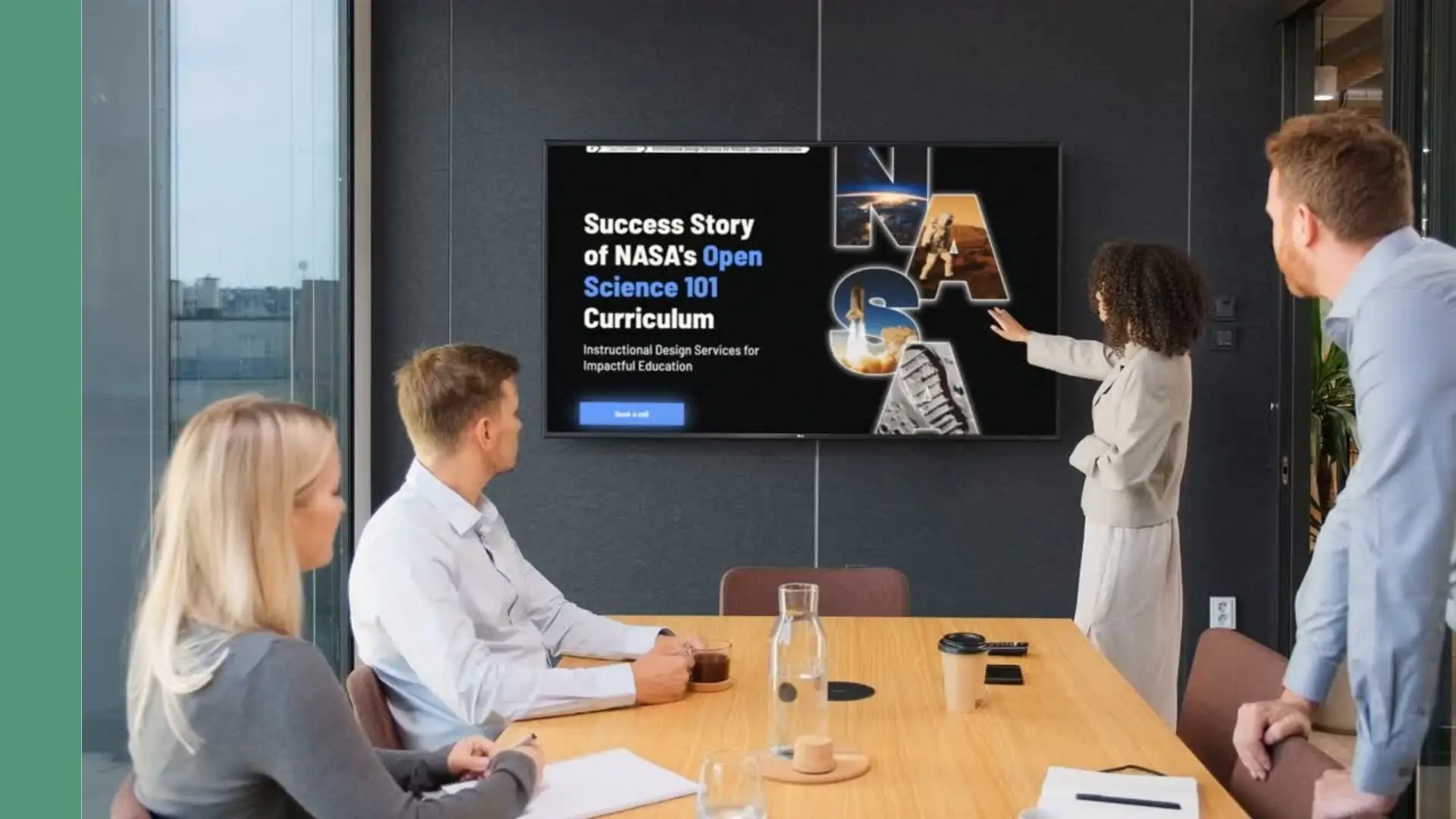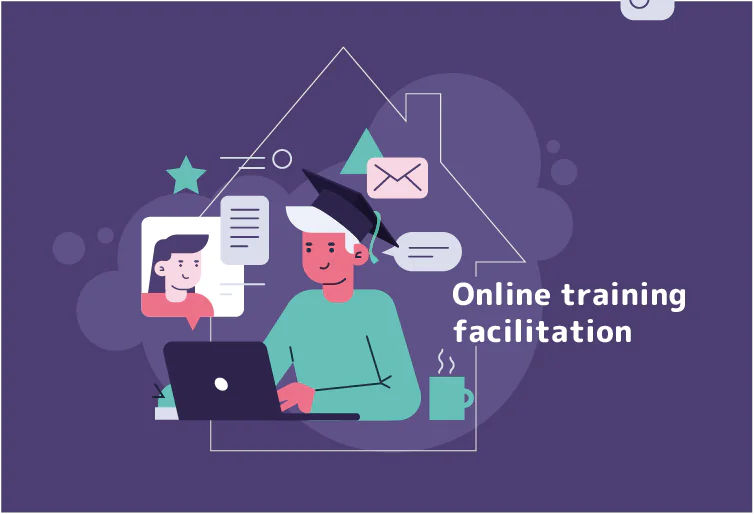Welcome to the Ultimate Guide to Developing and Launching an Online Course. This comprehensive material will be helpful for educators, subject matter experts, and professionals who are interested in creating impactful online courses or training. If you want your course to stand out and actually get results, keep reading.
Speaking of impactful learning, we recently helped NASA update one of its training courses. Now, the colonization of Mars feels a little closer. Curious how we did it? Read the case study — your course could be next.
6 Essential Steps to Create Online Training Courses
When creating online training courses, focus on two key things. First, make sure your course materials contribute to both personal and professional growth. That’s the best way to keep learners engaged.
The second thing to note is that creating online courses does not always equal selling online courses. Therefore, if you are looking to develop a course that will sell and, at the same time, will be in demand among students as a useful source of knowledge, you should follow the next six steps.
Step 1: Define Goals
To develop an online training course, you need to decide its main direction. For instance, is it aimed at instructing learners to use a new program or develop a specific skill? Sometimes, your developed eLearning course may be a short training program to improve employees’ digital products knowledge to serve customers better.
Remember, you need to know what you’re aiming for — because you can’t hit the target if you don’t know what it is.
Define Your Training Goals
All right, let’s kick things off by defining your training goals. For example, if I’m an experienced web developer looking to share my knowledge, my potential course objectives might be:
- Build basic web pages with HTML
- Create and publish a landing page
- Style pages using CSS
- Add interactivity with JavaScript
- Use browser developer tools
- Apply basic SEO and responsive design
Course Topic Selection
Now, it’s time to make the next move and choose the right topic. As a web developer, I’m really into front-end frameworks like React. I’ll draw on my expertise and interests to find that sweet spot.
I’m diving into online tools, surveys, and industry reports to gauge the demand. Are there job postings for React developers? Is there a buzz on social media about learning React? We want to offer a course that students need, not just because we like this topic.
Once you articulate the course objectives, you can assess whether a single module suffices or a series of learning paths is required.
Step 2: Structuring Your Online Course
Now that we have a clear understanding of our training goals and topic, let’s structure our online training course.
The course structure is a roadmap. We build it to guide our learners from A to Z. At this step, it is important for us to organize all types of content in a logical progression. Example for the React course: introduction to React, building components, and advanced state management.
Each module should continue the previous one — so your course flows naturally and doesn’t put the cart before the horse.
Topical Outline and Course Plan
- Create a topical outline
- Break it down into modules
- Define learning outcomes
- Plan key concepts and activities
- Include assessments
- Pay attention to collecting feedback
Step 3: Design Engaging Content to Develop Online Training Courses
The next step is to focus on design. At this step, it is essential for us to collect all course materials, including text, slide presentations, audio, and screen lessons.
Simply put, it is time to gather everything we have for training, PowerPoint presentations, product demos, webinars, manuals, or tutorials, and revise it. We should structure this content into an online course and make sure it aligns with our learning objectives, which we identified in the previous step.
It’s essential to have a clear vision of the assets and media types we’ll incorporate into our content.
Now, let’s explore engaging learning techniques to enrich our course and enhance the overall learning experience.
Gamification
Games and challenges can make training more fun. For example, try using simulations — realistic scenarios where learners pick the best solution. Add forums to get people talking. It keeps them involved and ready for the next part. Gamification in education is a magic wand. Don’t ignore its power 🪄
Step 4: Production and Delivery
When we have determined the formats for our course materials and planned their design, it’s time to choose the delivery methods for our online course. In other words, how will our students receive the content?
Pick the best delivery method for each lesson. Does it work better live, on-demand, or as a blend? Match the method to your goals and your learners. That’s how you make learning work.
In essence, tailoring the delivery methods to the course objectives and audience preferences is key to successful learning.
The Best Delivery Methods to Use When You Develop Online Training Courses
Choose the right format based on the content of each lesson:
- Live sessions – Great for topics that need real-time interaction, Q&A, or hands-on practice.
- Pre-recorded videos – Ideal for self-paced learning.
- Interactive elements – Use quizzes or simulations for skill checks and deeper engagement.
- Downloadable materials – Provide guides, checklists, or templates for offline reference.
Course Production Breakdown
Course production turns your plan into real content — videos, audio, and visuals — and, consequently, the quality you deliver plays a big role in keeping learners engaged.
| Phase | Focus Area | Key Considerations |
| Filming | Visual & Presentation Quality |
|
| Recording | Audio & Narration |
|
| Editing | Content Flow & Polish |
|
| Platform Selection | Delivery & Accessibility |
|
| Learner Access | Inclusivity & Usability |
|
| Accessibility | Diverse Learner Needs |
|
Step 5: Pricing and Marketing When You Develop Online Training Courses
We’re in the home stretch — it’s time to talk money and buzz.
First, figure out how valuable your course feels to learners. Is it a full-blown masterclass or a laser-focused niche guide? Think of pricing like setting the menu: a premium dish costs more than a quick snack. Your price should match what’s on the plate — depth, extras, and how much personal support you include.
Want more people at the table? Try offering a starter price or create bundles for different needs. Keep it fair, but don’t sell yourself short. People need to see that it’s worth the ticket.
Launch and Promotion
Now it’s showtime — your course is ready, and it’s time to turn heads.
Start by figuring out where your audience hangs out. Is it LinkedIn, email, Instagram, or somewhere else? Don’t shout into the void—go where the crowd already is.
Use sharp visuals, clear messaging, and content that tells a story. Make it obvious why your course is the real deal. Offer early-bird deals to create some FOMO. Throw in previews or mini-demos so people can get a taste before the main course.
And don’t go it alone. Partner with influencers or pros in your field — they can help you cast a wider net.
Illustrative Example: Calculating Marketing Investments and Dividends
Let’s break down the potential financial dynamics of marketing investments and the returns they can yield. We allocated a budget of $2,000 for marketing our online course.
| Сost item | $ |
| 1. Social Media Advertising: | $800 |
|
|
| 2. Email Campaigns: | $500 |
|
|
| 3. Influencer Partnership: | $700 |
|
|
| Total Investment: | $2,000 |
| Expected Dividends: | |
|
|
| Total Enrollments: 2,400 | |
| Now, let’s consider our established pricing structure. If the course is priced at $150 per enrollment, the potential revenue generated from these marketing efforts would be $360,000. | |
| Total Revenue: | $360,000 |
Step 6: Building a Learning Community
Your course doesn’t end with the last video or the final “thanks for your attention” slide. It’s time to build a community. A strong one makes people feel like they’re part of something bigger.
Set up places to chat — forums, live Q&As, or small group projects. Let them share tips, ask questions, and help each other out.
Don’t fly blind — ask your learners what’s working and what’s not. Quick surveys, feedback threads, or even open chats help you improve the course as you go.
In short: Make space for voices, not just lessons. That’s how you turn a course into a community.
Final Word: Your Course, Your Legacy
Creating a great course isn’t just ticking boxes — it’s planting seeds that grow far beyond the screen.
Here’s what a well-crafted course can do:
- Teach practical skills and boost learner confidence.
- Flash curiosity and a love for continuing education.
- Build a community where learners support each other.
Think of your course as more than course material — it’s a bridge to real change. And remember: you’re not just talking to a screen, you’re shaping futures.
🚀 Ready to Build a Course That Sticks?
Work with Raccoon Gang — we’ll help you take your course from idea to impact.
- 6 Essential Steps to Create Online Training Courses
- Step 1: Define Goals
- Step 2: Structuring Your Online Course
- Step 3: Design Engaging Content to Develop Online Training Courses
- Step 4: Production and Delivery
- Step 5: Pricing and Marketing When You Develop Online Training Courses
- Step 6: Building a Learning Community
- Final Word: Your Course, Your Legacy








